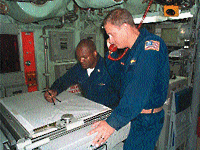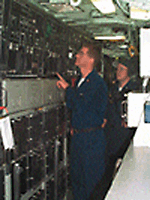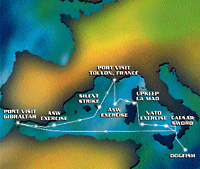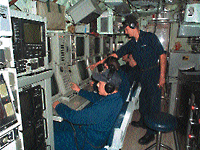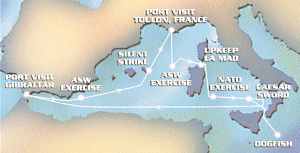 |
USS Boise's SSN Operations in the 21st Century by Steve Ross, Commander, USN |
| On 1 June, USS Boise (SSN-764) completed a multi-mission, multi-theater deployment that demonstrated how the nuclear attack submarine’s mobility, flexibility, and stealth will be vital to U.S. Navy forward presence and warfighting. We were the first SSN to deploy following participation in the revised Inter-Deployment Training Cycle (IDTC) recently instituted by Commander, Submarine Force, U.S. Atlantic Fleet (COMSUBLANT) to prepare submarines for six-month, multi-mission deployments. The baseline proficiency Boise developed during the training cycle was key to our success in making short-notice changes in both missions and mission areas during the deployment. This agility, long a requirement of forward-deployed naval forces, will become increasingly relevant as U.S. forces operate in the more complex and uncertain environments of the 21st century. Flexible and Mission Ready Shifting the focus of our underway training from specialized arctic operations to our new tasking, we arrived in Gibraltar less than one week after the re-routing order, ready for a completely different mission set: precision strike, anti-diesel-submarine operations, and coordinated battle group operations. Boise ran and played hard during our time in the Mediterranean. In a six-week period, we participated in three strike exercises and four multi-national anti-submarine warfare exercises, in addition to enjoying two liberty ports and a short upkeep. This rapid and varied pace permitted little more than refresher training prior to each operation, and it frequently took place in parallel with the current tasking. Nonetheless, the crew’s superb readiness for these short-fused assignments and the smooth transition we made between operating theaters showed that the Inter-Deployment Training Cycle had given us a solid foundation in all our baseline mission areas. Two of the exercises Boise participated in while in the Mediterranean were particular highlights – the Sixth Fleet Exercise CAESAR SWORD 98-1, a coordinated strike exercise, in which Boise acted as the Launch Area Coordinator (LAC); and DOGFISH, a coordinated ASW exercise, during which Boise successfully employed active sonar in locating quiet diesel-electric submarines.
Boise was the first SSN to
perform Launch Area Boise’s Strike Exercise Prior to CAESAR SWORD, our participation as a firing unit in other strike exercises had given us a good, basic understanding of the LAC’s role, but we had some significant challenges to overcome in doing it ourselves! These included restructuring the strike watch organization to handle LAC responsibilities with no additional personnel, practicing area coordination prior to the strike, and acting as the LAC while performing simultaneously as a firing unit. Not surprisingly, my crew developed innovative solutions that enabled us to rise to these challenges after only a few on-board rehearsals.
Two USS Boise torpedomen
operate the Weapons Launch Console Boise’s Combat Systems Officer (CSO), LT Joe Worthington, spearheaded the strike efforts by developing the LAC intentions message and corresponding communications and execution requirements. Since the ship had been underway during the entire period between being notified of the exercise and its execution, Joe had no external assistance. He and his principal assistant, LTJG Noel Gonzalez, “hit the books” and made it happen. Boise’s Engineer, LCDR Paul Spear, and RMC(SS) Marty Willis and RM2(SS) Ron Thomas of Radio Division joined Joe and Noel in forming the LAC cell. On-board practice sessions quickly showed the need to separate the LAC and firing unit duties, but for proper coordination, both groups had to be co-located in the ship’s Control Room. In practice, the LAC cell took station in the after end of the Control Room, where access to the TAC-3 computer, radio handsets, and the starboard Mk-19 plotter gave them all the tools required for coordinating the other firing units and communicating with the Strike Coordinator. Additionally, the LAC cell performed the usual firing unit external voice communications. Boise’s Executive Officer, LCDR Chuck Melcher, and the Reactor Controls Assistant, LT Matt Lobner, led the ship’s strike team, with Matt performing the duties of the Weapons Control Coordinator, normally handled by the CSO. LTJG Todd Figanbaum, FTC(SS) Mark DeVore, and FT1(SS) David Dalessio formed the core of the fire control team, executing our primary mission, and when the preprogrammed casualties occurred, they ensured a smooth transition to the Backup or Ready Spare missiles. The exercise was extremely successful. With the other firing units, City of Corpus Christi and Toledo, the Boise-led team successfully executed all missions, including the launch of the Backup and Ready Spare missiles. We showed conclusively that submarines have the connectivity to fulfill the LAC role. While surface ships remain the platform of choice for area coordination, the ability to put the LAC on a submarine gives operational commanders more flexibility in accomplishing precision strike from the sea. For instance, when a NO-NOTICE strike capability is needed, the submarine’s inherent stealth would allow a strike to be launched before the target country is alerted to U.S. intentions by the presence of surface ships or aircraft. Such a NO-NOTICE strike prevents the enemy from relocating missile defenses or shielding desired aim-points with civilians, as we’ve seen in the past. The use of an SSN in this scenario also improves the survivability of U.S. strike platforms if air superiority has not been established, or if the TLAM launch basket is inside shore missile defenses.
A full plate: Two port
visits, an upkeep, and more than a half dozen exercises Boise Anti-Diesel Submarine
Operations We had some recent experience operating against front-line diesel submarines in other areas but found very little success using passive sonar search tactics with legacy systems and sensors. Contact depended too heavily on a chance encounter or having your opponent make a mistake, such as generating inadvertent acoustic transients. In our work-up for DOGFISH, my Sonar Supervisors, led by STSC(SS) John Mondo, the Sonar Division Leading Chief Petty Officer, and the Officers of the Deck lobbied for active prosecution. They pointed out that our earlier passive searches were relatively ineffective, and they were confident in their active sonar proficiency. Further, Boise’s AN/BSY-1 active sonar suite is the best in the Navy and can be quite capable in suitable oceanographic conditions. STS1(SS) A. J. Lawson, the ship’s oceanographer, noted that the winter Mediterranean environment was ideal for the system. Although I was somewhat concerned about employing overt tactics against highly alerted submarines, I allowed my team to convince me that active sonar was the way to go. And they were right! Under the prevailing acoustic conditions, the primary advantage of an active approach was our ability to sweep out a large search area with high probability of gaining contact at long range. Then, staying outside of the enemy’s weapons envelope, we could safely close in for the kill. Despite our lack of covertness, deceptive techniques and coordination with supporting MPA permitted us to maneuver into position and simulate torpedo launch while holding contact solely on active sonar. With slight variations, these tactics resulted in more than a dozen successful attacks against three diesel-electric submarines, as well as the SSN. There is no question that the exercise scenario and ocean environment played a big role in our success. However, there’s an important lesson here in seeing how the innovative thinking of our young officers and Sailors – backed up by detailed technical knowledge and the Submarine Force’s tactical development arm – can produce effective warfighting solutions on scene and in near-real time.
USS Boise sonarmen conduct
an active Into the 21st Century — CDR Steve Ross is currently serving on the Joint Staff in the Pentagon. His previous assignment was as Commanding Officer USS Boise. |
|
NEWSLETTER
|
| Join the GlobalSecurity.org mailing list |
|
|
|


